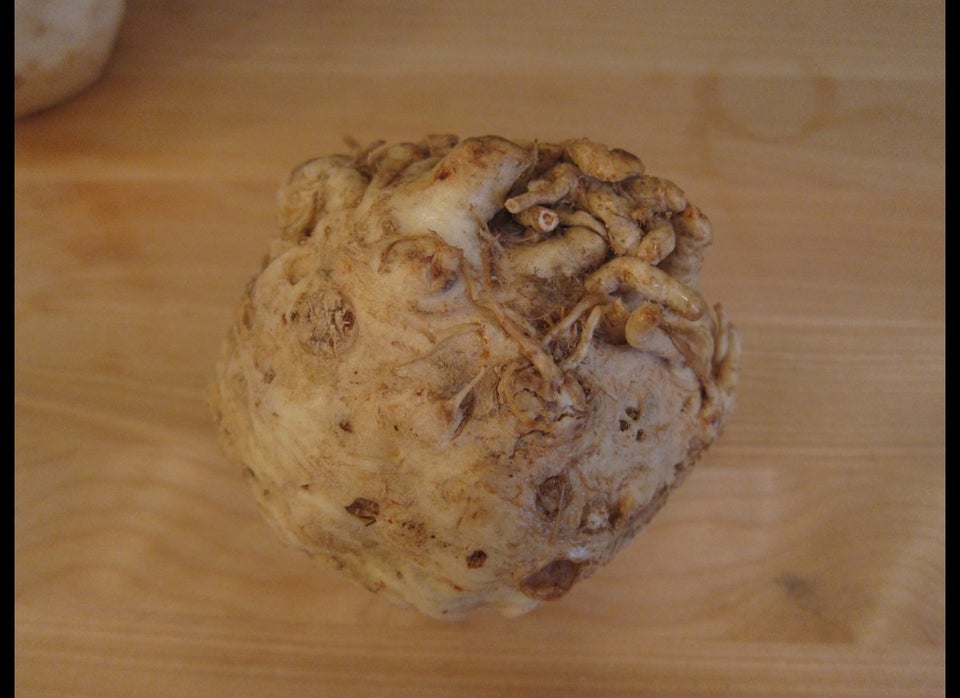One of the crisp lamb dishes I described a few weeks ago included a version of the so-called forgotten carrots Jackie and I had last year in London at Merchants Tavern, a restaurant that over three visits and counting has given me a number of good ideas for the home kitchen. The cooking technique (which includes "forgetting" the carrots in the oven until they appear to be overdone) intensifies the flavor and creates an aromatic, crusty exterior.
But why, I wondered, should it be limited to carrots? For years I've sometimes cooked vegetables in ways that had a similar flavor-concentrating effect -- "hypercooking" I call it -- but without the appealing caramelized crust. Besides carrots, my root-vegetable favorites for this treatment are parsnips and celery root (celeriac), and it seemed to me that they too would benefit from being "forgotten." I didn't have any parsnips in the house (odd at this time of year, but Jackie and I were about to take a trip and were trying to eat our way through the inventory), but did have a particularly nice, firm, fragrant celery root.
Here's how I cooked it (the procedure is the same for carrots, except that you don't need to peel them -- they need only be scrubbed -- or hold them in lemon-water). Having heated the oven to 325 or 330 degrees F (165 C), I squeezed half a lemon into a bowl of cold water, and as I peeled the celery root I dipped it into the lemony water, which kept it looking nice and white. I cut it into slices nearly one inch (2.5 cm) thick; start by halving the celeriac spheroid along its equator, then cutting one thick slice off each half. Even a smallish specimen will yield two neat slices plus the two end pieces; a huge one will yield twice as many, but these don't often come to farmers' markets in my area. Again, dip the slices in lemon-water, and keep them there if you're not going to use them right away. Bear in mind that the whole cooking process will require 70 or even 80 minutes but very little work.
Dry the slices and brown them in neutral oil over medium heat in a skillet that can go into the oven; the oil should be about 1/4 inch (6 mm) deep once you've added the vegetables. They should be golden on both sides; this can take 10 minutes, more or less. Drain the slices on paper towels and sprinkle them with salt; dump the oil and lightly wipe the pan with the same paper towels (don't mop up every drop of oil; it has celery flavor now). Return the pan to the fire; when it has reheated add a good chunk of butter. For my two big and two small slices, I used about 3 tablespoons (45 g). Deploying a bigger pan to hold more vegetable, use as much as you need to ensure that the celeriac slices are in butter, not just on it.
As the butter melts, also add some whole, not ground, spices. The chef of Merchants Tavern, Neil Borthwick, uses star anise and black cardamom with his forgotten carrots; you can use whatever spices you think harmonious. In this case, I used star anise (broken up), regular green cardamom and black peppercorns. I've been known to use fennel seed or caraway or shards of cinnamon stick; the one constant is the star anise, largely because it smells so good as it cooks.
When the butter foams, return the celery root to the pan, baste it once with butter and put the pan into the oven. After 25 or 30 minutes, turn the slices, and after another 25 or 30 minutes take them out of the pan (assuming they look nice and brown; if not, leave them for another 10 minutes), drain them, re-season them and serve them.
And how should you serve them? You could sprinkle them with crunchy salt, spritz them with lemon juice, add a grind of pepper and serve them as a light and surprising first course. You could serve them as part of a mixed vegetable dinner. Or you could serve them as a side dish with meat or fish. What I did last time was in the latter vein: I had leftovers from some boned pork butt that I'd braised with prunes. Once reheated, a slice of pork went onto a slice of celery root and a couple of the prunes on top of that, along with some of the sauce from the braise. It looked rather like tournedos Rossini if you could convince yourself that the prunes reminded you of truffles.
The intensity of flavor and sweetness achieved using this method means that, no matter how you serve them, the vegetables will stand up to whatever else is on the plate. And despite the lengthy cooking they do not dry out (only enough to concentrate the flavors) or lose their texture; in fact, because of the crusty exterior there's a net gain in that department.
This may be the best way of all to cook celery root, and since you can still find firm, well-stored examples through March and even into April, you should certainly give it a try.
